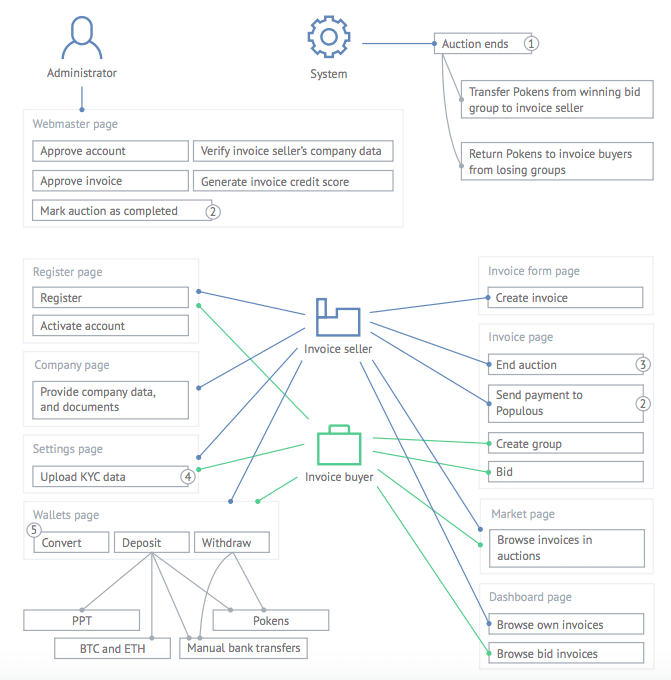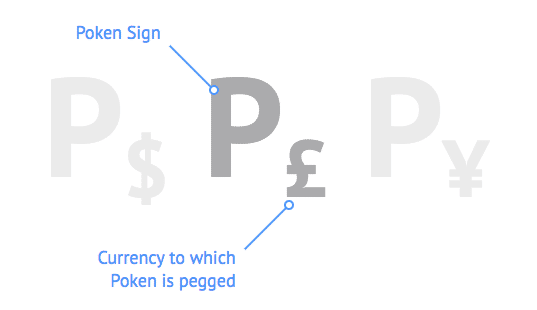Populous is a peer-to-peer (P2P) platform that uses blockchain to provide small and medium-sized enterprises (SMEs) a more efficient way to participate in invoice financing.
Having a consistent cash flow is a serious problem with many SMEs. Late invoice payments cost small businesses in the United Kingdom over $2 billion each year in fees and missed opportunities. Using invoice financing, businesses can sell their outstanding invoices at a discount to quickly free up some cash. The person buying the invoice effectively takes it over and receives the money when the client pays.
Populous uses blockchain technology, XBRL data, and the Altman Z-score formula (more on this later) to expand invoice financing globally and create an overall improved system.
WARNING: Since the initial publication of this article, several issues have come to light. Luxure apparently scrapped the partnership with Populous in February and stated that they never authorized the announcement. Additionally, the Populous team has since removed the announcements of the partnership and the PXT airdrop from Medium. These actions and other doings have caused many community members to claim that Populous is, in fact, a scam.
In this Populous guide, we’ll touch on:
- How Does Populous Work?
- Poken vs. PPT vs. PXT
- Populous Team & Progress
- Trading
- Where to Buy PPT
- Where to Store PPT
- Conclusion
- Additional Populous Resources
How Does Populous Work?
On Populous, buyers and sellers exchange invoices through auctions using smart contracts. To sell an invoice, you first need to register your company. You then have a hold on your account until you receive approval from the Populous administrator.
Once the administrator approves you as a seller, you can submit an invoice and set a minimum sales goal. This also needs administrator approval.
XBRL (eXstensible Business Reporting Language)
Populous analyzes the credit risk of invoices by using the Altman Z-score formula on real-time XBRL data. This data is publicly available and includes business information such as the debtor’s value, the amount of cash on hand, and the creditors that are due within a year.
Altman Z-score Formula
With the extracted XBRL data and the Altman Z-Score formula, the Populous team has created their own in-house credit rating system. Because of this, they have no need for an external credit agency, saving them a significant amount of time and money.
The Altman Z-score Formula is a financial modeling tool that determines three risk factors:
- Probability a business will be bankrupt within two years
- Whether the business will default on obligations
- Control measure for financial distress
Beyond evaluating invoices, Populous uses these two sets of data to target companies in need of cash flow and filter out business applicants who aren’t a good fit for the platform.
Whether the administrator rejects or approves the invoice sales inquiry is determined by the Altman Formula credit score.
The invoice auction begins once your invoice is approved, and it lasts for 24 hours. There are only three possible ways for an auction to end:
- A successful auction occurs, and a bid matches your sales goal within the 24-hour period.
- 24 hours pass and no bid meets the sales goal requirement. In this situation, you can either accept the best bid available, cancel the auction, or restart the auction again.
- You terminate the auction early. When doing this, you can completely cancel the auction, or you can accept the best bid available.
Upon successful completion of an auction, the seller receives the funds from the buyer in the form of Pokens, the digital currency within the Populous platform. Sellers can then exchange these for fiat if they wish.
All buyers who lost the auction will have their funds returned to them. Canceled auctions also result in the return of funds to buyers.

Invoice Buyers
If you plan on buying invoices, you also need to get approval from the administrator before starting. You’re required to enter KYC information when buying invoices.
As a buyer, you can either establish bids on your own or be part of a bidding group. Bidding groups consist of individual bidders who enter an auction as one entity to make bids.
Poken vs. PPT vs. PXT
Populous has three tokens, and it can be fairly easy to confuse them all.
Pokens
Pokens are the internal currency of the Populous platform. Each Poken is pegged directly to the equivalent amount of fiat currency (e.g. in the U.K., 1 GBP Poken equals 1 GBP). These ERC-20 tokens are what you use to purchase invoices.

You can purchase Pokens directly on Populous with GBP, USD, EUR, and Yen. Other currencies will be converted to GBP using the London Stock Exchange exchange rate before purchasing the Pokens. You’re also able to use supported cryptocurrencies like Bitcoin and Ethereum to purchase Pokens.
Pokens are an ERC-20 token and thus can be stored in any wallet that supports ERC-20 tokens.
PPT (Populous Platform Token)
PPT tokens were distributed during the Populous ICO and are primarily used as investment vehicles. Only about 53 million PPT will ever be in circulation.
Other than holding them, you can use your PPT to invest in invoices through Liquidity Pools.
When you invest in an invoice using PPT, your tokens are put up as collateral for the investment. In exchange, you receive Pokens which Populous automatically uses to buy the invoice. Once the invoice is repaid, you receive the Pokens profit and your original PPT investment.
PXT (Populous XBRL Token)
PXT is new to Populous. It’s an ERC20 token that you spend to access Business Intelligence (BI) data on the Populous XBRL Platform (PXP). The PXP gives you access to the over one petabyte (that’s one quadrillion bytes) of business data that the network houses. You can use this data to create customized reports regarding credit scores, business financial health, SWOT analyses, and potential customers among many other things.
Populous Team & Progress
The Populous project is based in London and led by Stephen Williams. Williams previously founded Olympus Research, a company focused on commercial data and analytics for businesses.

Populous began in 2017. The company launched their beta version 1.0 in February 2018 and a public beta in May the same year. In October, the team released the PXP in open build mode to the public. They have not published a roadmap.
Competition
There don’t appear to be any major Populous competitors in the blockchain space. The biggest challenge Populous faces is getting clients to switch from traditional invoice financing channels.
The incentive for invoice sellers to make the switch is seemingly simple: Populous is less expensive to use. Invoice buyers are incentivized to switch platforms because of the in-house credit rating system. Populous markets this system as a vast improvement to the current rating methods available.
[thrive_leads id=’5219′]
Trading
The Populous team held their ICO in July 2017 in which they raised over $10 million. After the ICO, the PPT price remained relatively stagnant between $2.00-$4.00 (~0.0005-0.0007 BTC) until November. For the remainder of 2017 (and the start of 2018), it rose to hit an all-time high of around $68.91 (~0.00595 BTC).
A few important announcements seemed to have caused the price increase. The team announced a partnership with Luxure Global Citizen, a company that sells ridiculously expensive items like Lamborghinis. The announcement implied that it would lead to some pretty hefty invoices. The Populous beta was also expected to be available before the end of the year helping to drive up the price. Lastly, the team announced an airdrop of the new PXT token.
Following the January 2018 run-up, the PPT price fell for almost all of the remainder of 2018. The coin experienced one spike in April, but it’s unclear what may have caused this. It now rests at around $1.50 (~0.000415 BTC).
Without a market turnaround or any serious partnerships, it’s unlikely that the PPT price will get some legs again.
Where to Buy PPT
PPT is a little bit tougher to purchase than most other large market cap cryptocurrencies. However, you can get it on Binance as a trading pair with Bitcoin and Ethereum.
For a complete list of the exchanges where PPT is available, head over to CoinMarketCap.
Where to Store PPT
Because PPT is an ERC-20 token, you have quite a few options on where to store it. Two popular options for storage are MetaMask and MyEtherWallet.
If you’re looking for more security (and who isn’t?), you should look into using a hardware wallet like Trezor or the Ledger Nano S. Both wallets support all ERC-20 tokens including PPT.
Conclusion
Populous is a young project with a lot to prove. The team does not have much experience with blockchain technology, and the controversy around the project should raise some red flags.
Additionally, the current market cap of the project is significantly higher than other cryptocurrency projects that are targeting much larger customer bases. However, the launch of the PXP is a strong move that may help to extend its market reach.
With the PPT price at all-time low levels, the project is at a make or break point for the Populous team. Hopefully, they can gain some notable partnerships or show significant adoption soon to prove their legitimacy. If not, the naysayer could have the final word after all.
Editor’s Note: This article was updated by Steven Buchko on 12.05.2018 to reflect the recent changes of the project.





